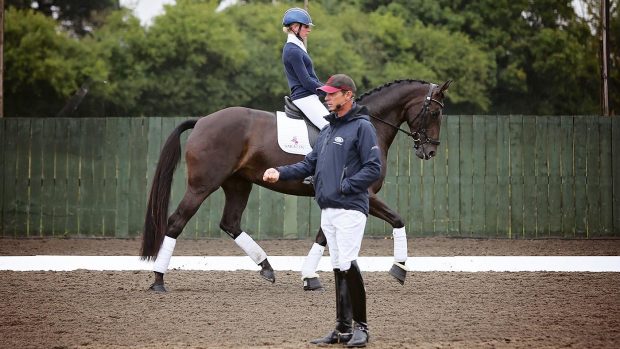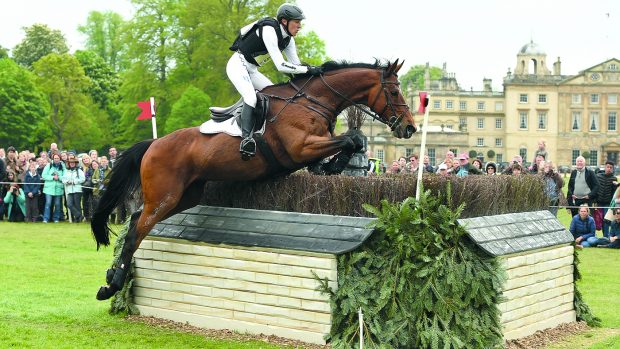When Tiger time qualified for and then won the restricted novice championship at last year's National Dressage Championships, he won many fans. This year he's off on a winning course again so we talk to his trainer, Sharon Brooks, about her methods and how he does so well
Traditional cob stallion Tiger Tim came to our attention last year when he qualified for and then won the restricted novice championship at the National Dressage Championships. This week he was back in the ribbons winning the novice open freestyle test and an award for the weekend’s highest score (79.44%) at the Winter Regional Championships held at Kingston Maurward (full report 27 February issue).
This unconventional 14.2hh champion, bred and owned by Denise Kersley, is trained by stud owner and breeder Sharon Brooks of Coombe Cross Farm. We asked Sharon what she has been working on with Tiger Tim and his rider Alysia Matravers, for her tips on preparing a winning freestyle programme on a less than conventional horse and for a little more about her training philosophy.
“We’ve taken Timmy from prelim though to novice and elementary. Everything is now geared to increasing his engagement quality and his ability to centralise his balance. It is easy to create more energy but not to keep in balance, too. Stallions tend to sit behind the leg, they are very quick to hold themselves, so we do a lot of work in trot within the pace, forwards and back.
If you do this on a circle, going into medium and then back to collected, it is more difficult than on the diagonal. It also develops more suppleness through the back and balance through the circle. It helps to keep the hind leg engaged underneath the horse, if you send them forward.
Stallions tend to go a bit wide behind if you are not careful. A good thing for this is to work in shoulder-fore, shoulder-in down the long side, this helps keeps the hind legs close as long as you keep pushing forwards.
Tiger Tim already has good medium and extended trot and he could go to prix st georges. There is no reason why he can’t do changes and pirouettes which both come into that level. The only thing we have to do is build the strength.”
Sharon’s 6 tips on planning a freestyle to suit your horse
1. The key point putting Timmy’s floorplan together is to make it logical in a way that is easy to follow. A busy test can be really difficult to follow for the judges, especially after waching a few. Keep it logical incorporating all the points you want to put in.
2. It is very easy to think you have done everthing equally on both reins — double check.
3. Your plan must work the horse to his strengths to show off his good points and quality. You want to get the judges’ attention, for them to think ’that’s good, that’s nice’. Tiger Tim has very good extension. In his floorplan we went up the centre line halted, took two steps of normal trot out of halt and turned off on a diagonal line in extension across the quarter marker towards the judge.
4. When you’re riding your test don’t do too much on the outside track — you are almost doing a normal dressage test. Incorporate the three-quarter line, diagonals and the centre line. If you’re good at shoulder-in, do it down the three-quarter line. In effect you are increasing your level of difficulty.
5. Try to choose music that possibly your judges can relate too, nothing too obscure. It is easier to pick up the rhythm if you know the sort of music. The whole picture becomes more harmonious. Also, try not to select the same type of music that everyone else is riding too.
6. As you get to the higher levels it is important to phase the music with the movements your are doing. Try to build up into a medium trot and phase it out towards the end. What you don’t want is background music.
What’s your USP?
Because I ride and handle stallions, I feel that I have a good knowledge of temprement. Handling stallions at their most vulnerable moments gives you a greater sympathy when you come to train them. This goes for mares, too, which I think of as ‘entires’ in that they have a full quota of hormones. For instance, with my stallion even if we are not collecting from him [for AI] for a week or so, I will still collect off him twice a week, it keeps him happy and relaxed.
What’s your pet hate?
I notice riders tend to turn their horses through the nose. My philosophy is to turn the shoulders of the horse with a bend in the body.
Share with us your signature exercise
This is something that we have worked into Tiger Tim’s freestyle. Ride a succession of circles, either 10 metre or 12 metre, down the centre line, from one rein to the other. Most horses are stiffer one way. This is a very good exercise; it highlights the changeover from one rein to the other and will show when a horse isn’t connecting equally.
If we were to ask your pupils, what would be the one thing they all say you continually shout?
Shorten your reins!
To contact Sharon, who is based in Wincanton, Somerset, visit www.coombecrossfarmstud.co.uk or call 07970 793821



